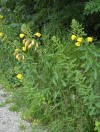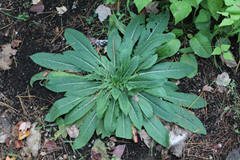WILD
FOODIES' HOME PAGE
PLANT PROFILE LIST
NAME: Evening Primrose
SPECIES / FAMILY: Oenothera Biennis / Onagraceae
OTHER COMMON NAME(S): Sun Drop
CONDITIONS: sun
|
PARTS: |
EDIBLE |
TASTE |
RAW/COOK |
SEASON |
|
All |
|
|
|
|
|
Shoots |
|
slimy/pepper |
RAW/COOK |
Spring |
|
Leaves |
||||
|
Stalk/Stem |
|
|
PEEL/RAW/COOK |
Summer |
|
Buds |
||||
|
Flowers |
|
sweet |
RAW/COOK |
Summer |
|
Fruits |
|
|
|
|
|
Pods |
|
|
COOK |
Summer |
|
Seeds |
|
|
|
|
|
Nuts |
|
|
|
|
|
Roots |
|
sweet/peppery |
COOK |
Fall/earlySpring |
|
Bark |
|
|
|
|
PORTION: small
COMMENT: Biennial - two year plant. Root of first year plant – taste resembles salsify or parsnips. Stalk of second year. Flowers - used in salads or as a garnish. Caution: eat shoots sparingly. (1) Stalk – second year (2) "Evening primrose is a biennial, and only flowers in it's second year. Those stalks have sent all of their energy into the flowers, and their roots are tough and not good for eating (trust me, I tried). But look down, and you'll see the rosette of first-year leaves (which are slightly fuzzy and have a almost glowing reflective white mid-rib) close to the ground, with no flower stalk. Those are the ones you want to dig for roots. For the bet flavor, wait until it has frosted several times and the ground has gone cold before digging evening primrose root. Before that time, the roots can be unpleasantly spicy. Some even report a tingling/burning sensation when eating them." (6)
CAUTION: “Lowers the threshold for epileptic fits (avoid). Caution if on anticoagulants. Combining with phenothiazines (allopathic medication) can trigger seizures. Adverse effects: may cause headaches and nausea on an empty stomach. Diarrhoea with high doses. Seizures in schizophrenic patients on phenothiazines (allergy antihistamines).”(1)
NUTRITION/MEDICINAL: Anticholesterolemic; Antipruritic; Astringent; Hypotensive; Miscellany; Sedative.(1) The seed contains 28% of a drying oil. It is edible and a very good source of gamma-linolenic acid, an essential fatty acid that is not found in many plant sources and has numerous vital functions in the body. The seed, however, is very small and difficult to harvest, it has to be done by hand. Overall yields are low, making the oil very expensive to produce.(1) Also: https://www.webmd.com/vitamins/ai/ingredientmono-1006/evening-primrose-oil
LOOK-A-LIKES:
POISONOUS LOOK-A-LIKES:
OTHER USES: “Cosmetic; Dye; Miscellany; Oil. The oil from the seed is added to skin preparations and cosmetics. It is often combined with vitamin E to prevent oxidation. A yellow dye is obtained from the flowers. A finely ground powder made from the flowering stems is used cosmetically in face-masks to counteract reddened skins.”(1)
SOURCE LINKS (may include nutritional and medicinal info, plus other uses):
- https://pfaf.org/user/Plant.aspx?LatinName=Oenothera+biennis
- http://www.eattheweeds.com/oenothera-biennis-foraging-standby-2
- https://en.wikipedia.org/wiki/Oenothera_biennis
- http://www.foragingtexas.com/2011/12/cutleaf-evening-primrose.html - related
- http://www.ediblewildfood.com/evening-primrose.aspx (good photos)
- http://hungerandthirstforlife.blogspot.com/2010/10/wild-about-evening-primrose-root.html#:~:text=Those%20are%20the%20ones%20you,burning%20sensation%20when%20eating%20them.



